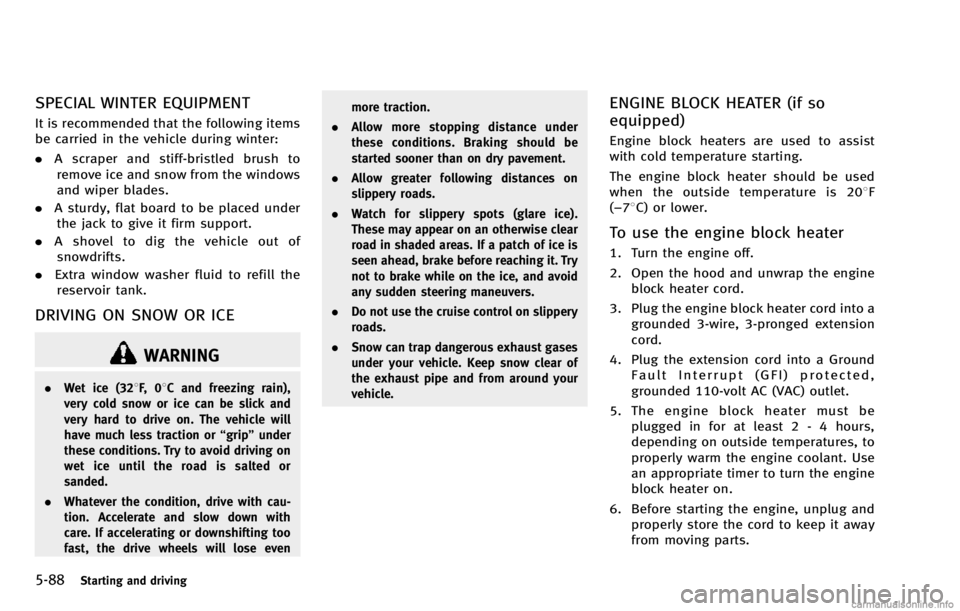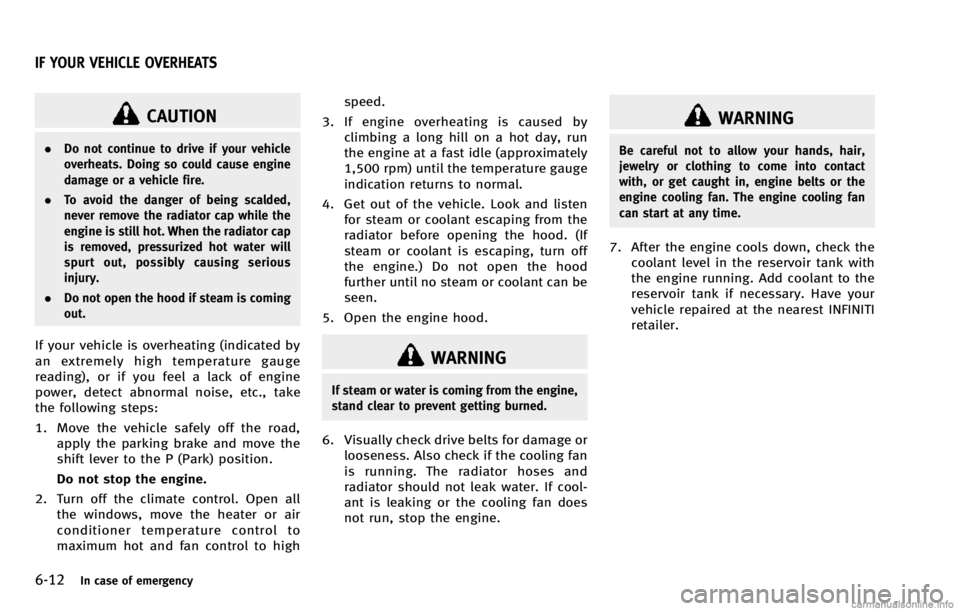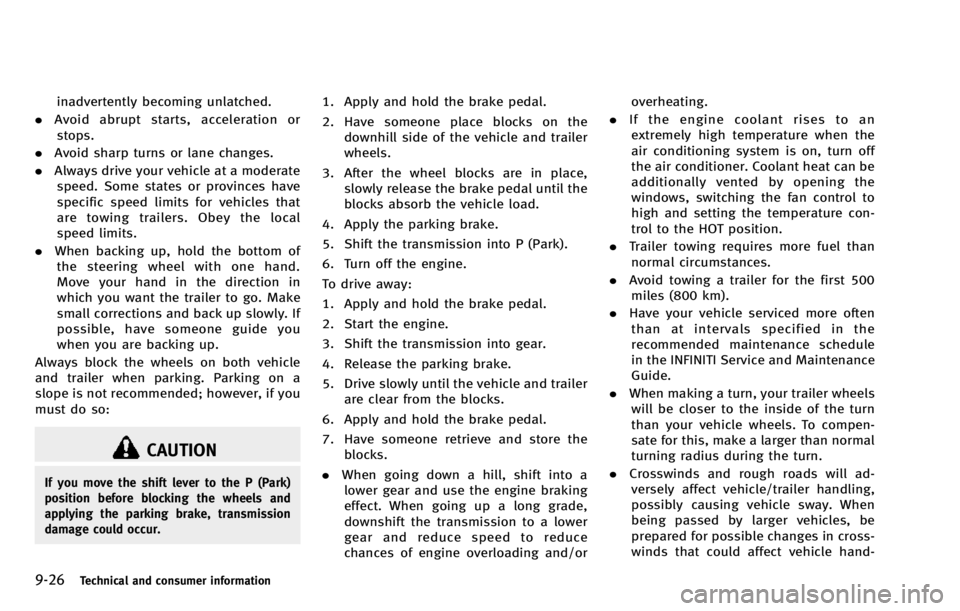stop start INFINITI QX70 2014 Workshop Manual
[x] Cancel search | Manufacturer: INFINITI, Model Year: 2014, Model line: QX70, Model: INFINITI QX70 2014Pages: 530, PDF Size: 2.48 MB
Page 413 of 530

5-86Starting and driving
bars, bushings and wheels are not
INFINITI recommended for your vehicle
or are extremely deteriorated, the VDC
system may not operate properly. This
could adversely affect vehicle handling
performance, and the VDC warning light
may illuminate.
. If brake related parts such as brake
pads, rotors and calipers are not INFINITI
recommended or are extremely deterio-
rated, the VDC system may not operate
properly and the VDC warning light
may illuminate.
. If engine control related parts are not
INFINITI recommended or are extremely
deteriorated, the VDC warning light
may illuminate.
. When driving on extremely inclined
surfaces such as higher banked corners,
the VDC system may not operate prop-
erly and the VDC warning light
may
illuminate. Do not drive on these types
of roads.
. When driving on an unstable surface
such as a turntable, ferry, elevator or
ramp, the VDC warning light
may
illuminate. This is not a malfunction.
Restart the engine after driving onto a stable surface.
. If wheels or tires other than the INFINITI
recommended ones are used, the VDC
system may not operate properly and
the VDC warning light
may illumi-
nate.
. The VDC system is not a substitute for
winter tires or tire chains on a snow
covered road.
The Rear Active Steer system is an electro-
nically controlled four-wheel steering sys-
tem.
The angle of the rear wheels are adjusted
by the Rear Active Steer system, depending
on the vehicle speed and steering angle.
The rear wheels are designed to turn
momentarily in the opposite direction and
then change to the same direction as the
front wheels.
At low speeds, the rear wheels will not turn
and the system functions as a two-wheel
steering system.
If a malfunction occurs in the system, the
Rear Active Steer function will stop but the
ordinary two-wheel steering system will
operate normally. The “RAS”warning light
will illuminate. If the light illuminates while
driving, contact an INFINITI retailer for
repair.
WARNING
The Rear Active Steer system, although a
sophisticated device, cannot prevent acci-
dents resulting from careless or dangerous
driving techniques. Ultimately the responsi-
bility for safety of self and others rests in
the hands of the driver. Therefore only
REAR ACTIVE STEER SYSTEM (if so
equipped)
Page 415 of 530

5-88Starting and driving
SPECIAL WINTER EQUIPMENT
It is recommended that the following items
be carried in the vehicle during winter:
.A scraper and stiff-bristled brush to
remove ice and snow from the windows
and wiper blades.
. A sturdy, flat board to be placed under
the jack to give it firm support.
. A shovel to dig the vehicle out of
snowdrifts.
. Extra window washer fluid to refill the
reservoir tank.
DRIVING ON SNOW OR ICE
WARNING
. Wet ice (328F, 0 8C and freezing rain),
very cold snow or ice can be slick and
very hard to drive on. The vehicle will
have much less traction or “grip”under
these conditions. Try to avoid driving on
wet ice until the road is salted or
sanded.
. Whatever the condition, drive with cau-
tion. Accelerate and slow down with
care. If accelerating or downshifting too
fast, the drive wheels will lose even more traction.
. Allow more stopping distance under
these conditions. Braking should be
started sooner than on dry pavement.
. Allow greater following distances on
slippery roads.
. Watch for slippery spots (glare ice).
These may appear on an otherwise clear
road in shaded areas. If a patch of ice is
seen ahead, brake before reaching it. Try
not to brake while on the ice, and avoid
any sudden steering maneuvers.
. Do not use the cruise control on slippery
roads.
. Snow can trap dangerous exhaust gases
under your vehicle. Keep snow clear of
the exhaust pipe and from around your
vehicle.
ENGINE BLOCK HEATER (if so
equipped)
Engine block heaters are used to assist
with cold temperature starting.
The engine block heater should be used
when the outside temperature is 208 F
(−78C) or lower.
To use the engine block heater
1. Turn the engine off.
2. Open the hood and unwrap the engine block heater cord.
3. Plug the engine block heater cord into a grounded 3-wire, 3-pronged extension
cord.
4. Plug the extension cord into a Ground Fault Interrupt (GFI) protected,
grounded 110-volt AC (VAC) outlet.
5. The engine block heater must be plugged in for at least 2 - 4 hours,
depending on outside temperatures, to
properly warm the engine coolant. Use
an appropriate timer to turn the engine
block heater on.
6. Before starting the engine, unplug and properly store the cord to keep it away
from moving parts.
Page 429 of 530

6-12In case of emergency
CAUTION
.Do not continue to drive if your vehicle
overheats. Doing so could cause engine
damage or a vehicle fire.
. To avoid the danger of being scalded,
never remove the radiator cap while the
engine is still hot. When the radiator cap
is removed, pressurized hot water will
spurt out, possibly causing serious
injury.
. Do not open the hood if steam is coming
out.
If your vehicle is overheating (indicated by
an extremely high temperature gauge
reading), or if you feel a lack of engine
power, detect abnormal noise, etc., take
the following steps:
1. Move the vehicle safely off the road,
apply the parking brake and move the
shift lever to the P (Park) position.
Do not stop the engine.
2. Turn off the climate control. Open all the windows, move the heater or air
conditioner temperature control to
maximum hot and fan control to high speed.
3. If engine overheating is caused by climbing a long hill on a hot day, run
the engine at a fast idle (approximately
1,500 rpm) until the temperature gauge
indication returns to normal.
4. Get out of the vehicle. Look and listen for steam or coolant escaping from the
radiator before opening the hood. (If
steam or coolant is escaping, turn off
the engine.) Do not open the hood
further until no steam or coolant can be
seen.
5. Open the engine hood.WARNING
If steam or water is coming from the engine,
stand clear to prevent getting burned.
6. Visually check drive belts for damage or looseness. Also check if the cooling fan
is running. The radiator hoses and
radiator should not leak water. If cool-
ant is leaking or the cooling fan does
not run, stop the engine.
WARNING
Be careful not to allow your hands, hair,
jewelry or clothing to come into contact
with, or get caught in, engine belts or the
engine cooling fan. The engine cooling fan
can start at any time.
7. After the engine cools down, check the coolant level in the reservoir tank with
the engine running. Add coolant to the
reservoir tank if necessary. Have your
vehicle repaired at the nearest INFINITI
retailer.
IF YOUR VEHICLE OVERHEATS
Page 465 of 530

8-22Maintenance and do-it-yourself
wipe the inside of the air cleaner housing
and the cover with a damp cloth.
WARNING
.Operating the engine with the air
cleaner removed can cause you or others
to be burned. The air cleaner not only
cleans the air, it stops flame if the
engine backfires. If it isn’t there, and the
engine backfires, you could be burned.
Do not drive with the air cleaner
removed, and be careful when working
on the engine with the air cleaner
removed.
. Never pour fuel into the throttle body or
attempt to start the engine with the air
cleaner removed. Doing so could result
in serious injury.
CLEANING
If your windshield is not clear after using
the windshield washer or if a wiper blade
chatters when running, wax or other
material may be on the blade or wind-
shield.
Clean the outside of the windshield with a
washer solution or a mild detergent. Your
windshield is clean if beads do not form
when rinsing with clear water.
Clean each blade by wiping it with a cloth
soaked in a washer solution or a mild
detergent. Then rinse the blade with clear
water. If your windshield is still not clear
after cleaning the blades and using the
wiper, replace the blades.
Worn windshield wiper blades can damage
the windshield and impair driver vision.
WINDSHIELD WIPER BLADES
Page 513 of 530

9-26Technical and consumer information
inadvertently becoming unlatched.
. Avoid abrupt starts, acceleration or
stops.
. Avoid sharp turns or lane changes.
. Always drive your vehicle at a moderate
speed. Some states or provinces have
specific speed limits for vehicles that
are towing trailers. Obey the local
speed limits.
. When backing up, hold the bottom of
the steering wheel with one hand.
Move your hand in the direction in
which you want the trailer to go. Make
small corrections and back up slowly. If
possible, have someone guide you
when you are backing up.
Always block the wheels on both vehicle
and trailer when parking. Parking on a
slope is not recommended; however, if you
must do so:
CAUTION
If you move the shift lever to the P (Park)
position before blocking the wheels and
applying the parking brake, transmission
damage could occur.
1. Apply and hold the brake pedal.
2. Have someone place blocks on the downhill side of the vehicle and trailer
wheels.
3. After the wheel blocks are in place, slowly release the brake pedal until the
blocks absorb the vehicle load.
4. Apply the parking brake.
5. Shift the transmission into P (Park).
6. Turn off the engine.
To drive away:
1. Apply and hold the brake pedal.
2. Start the engine.
3. Shift the transmission into gear.
4. Release the parking brake.
5. Drive slowly until the vehicle and trailer are clear from the blocks.
6. Apply and hold the brake pedal.
7. Have someone retrieve and store the blocks.
. When going down a hill, shift into a
lower gear and use the engine braking
effect. When going up a long grade,
downshift the transmission to a lower
gear and reduce speed to reduce
chances of engine overloading and/or overheating.
. If the engine coolant rises to an
extremely high temperature when the
air conditioning system is on, turn off
the air conditioner. Coolant heat can be
additionally vented by opening the
windows, switching the fan control to
high and setting the temperature con-
trol to the HOT position.
. Trailer towing requires more fuel than
normal circumstances.
. Avoid towing a trailer for the first 500
miles (800 km).
. Have your vehicle serviced more often
than at intervals specified in the
recommended maintenance schedule
in the INFINITI Service and Maintenance
Guide.
. When making a turn, your trailer wheels
will be closer to the inside of the turn
than your vehicle wheels. To compen-
sate for this, make a larger than normal
turning radius during the turn.
. Crosswinds and rough roads will ad-
versely affect vehicle/trailer handling,
possibly causing vehicle sway. When
being passed by larger vehicles, be
prepared for possible changes in cross-
winds that could affect vehicle hand-
Page 520 of 530

10 Index
A
ABS (Anti-lock Braking System) ......................... 5-83
Adaptive front lighting system (AFS) .................. 2-42
Adaptive shift control (ASC) .............................. 5-19
Advanced air bag system .................................. 1-42
Aiming control, Adaptive front lighting
system (AFS) ..................................................... 2-42
Air bag systemAdvanced air bag system ............................. 1-42
Front passenger air bag and status light ...... 1-44
Front-seat mounted side-impact
supplemental air bag system ....................... 1-47
Roof-mounted curtain side-impact and rollover
supplemental air bag system ....................... 1-47
Air bag warning labels ...................................... 1-50
Air bag warning light ............................... 1-50, 2-18
Air cleaner housing filter ................................... 8-21
Air conditioner Advanced Climate Control System (ACCS) ..... 4-52
Air conditioner service ................................. 4-54
Air conditioner specification label ................ 9-13
Air conditioning system refrigerant and
lubricant recommendations .................. 4-54, 9-7
Automatic climate control .................. 4-48, 4-51
In-cabin microfilter ....................................... 4-54
Alarm, How to stop alarm (see vehicle
security system) ................................................ 2-32
Alcohol, drugs and driving .................................. 5-8
All-wheel drive (AWD) ........................................ 5-76
All-wheel drive (AWD) warning light .................. 2-14 Antenna ............................................................ 4-91
Anti-lock Braking System (ABS) ......................... 5-83
Anti-lock braking system (ABS) warning light .... 2-14
Appearance care
Exterior appearance care ................................ 7-2
Interior appearance care ................................ 7-4
Armrest ............................................................. 1-10
Around View
TMMonitor (AVM) ........................... 4-31
Audible reminders ............................................ 2-22
Audio operation precautions ............................. 4-54
Audio system .................................................... 4-54 Steering wheel audio controls ...................... 4-90
Auto closure ..................................................... 3-23
Autolight system ............................................... 2-39
Automatic Automatic transmission fluid (ATF) ............... 8-15
Climate control .................................. 4-48, 4-51
Door locks ..................................................... 3-5
Drive positioner ........................................... 3-32
Driving with automatic transmission ............ 5-15
Moonroof ..................................................... 2-62
Seat positioner ............................................ 3-32
Average fuel consumption and speed ................ 2-29
Avoiding collision and rollover ............................ 5-6
B
Back door (See lift gate) ................................... 3-18
Battery .............................................................. 8-17
Battery saver system ................................... 2-40 Intelligent Key .............................................. 8-27
Variable voltage control system ................... 8-19
Before starting the engine ................................ 5-14
Belts (See drive belts) ....................................... 8-19
Bluetooth
®hands-free phone system
(models with navigation system) ....................... 4-93
Bluetooth
®hands-free phone system
(models without navigation system) ................ 4-103
Bluetooth streaming audio .............. 4-67, 4-82, 4-91
Booster seats .................................................... 1-34
Brake
Anti-lock Braking System (ABS) .................... 5-83
Brake fluid ................................................... 8-16
Brake system ............................................... 5-80
Parking brake operation ............................... 5-20
Warning light ............................................... 2-14
Break-in schedule ............................................. 5-74
Brightness control Display ON/OFF button .................................. 4-9
Instrument panel ......................................... 2-43
Bulb check/instrument panel ............................ 2-13
Bulb replacement .............................................. 8-29
C
Cabin air filter ................................................... 4-54
Capacities and recommended fuel/lubricants ...... 9-2
Car phone or CB radio ...................................... 4-92
Cargo (See vehicle loading information) ............ 2-56
Cargo cover....................................................... 2-57